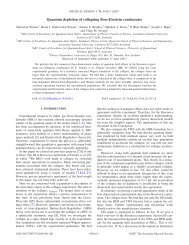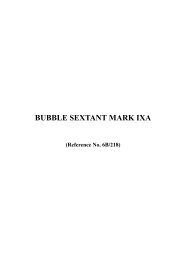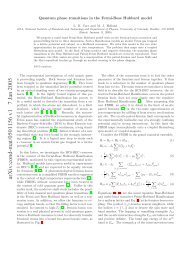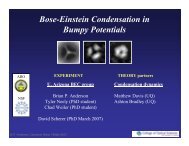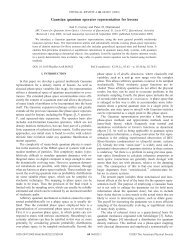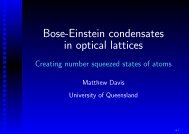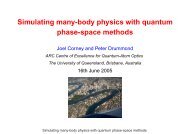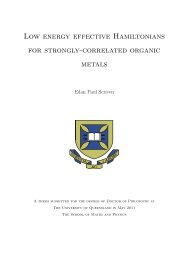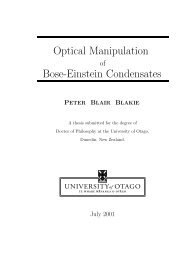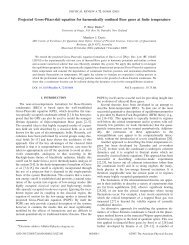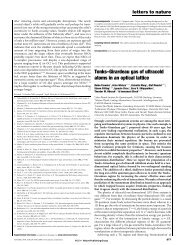Open Quantum Dynamics of Mesoscopic Bose-Einstein ... - Physics
Open Quantum Dynamics of Mesoscopic Bose-Einstein ... - Physics
Open Quantum Dynamics of Mesoscopic Bose-Einstein ... - Physics
Create successful ePaper yourself
Turn your PDF publications into a flip-book with our unique Google optimized e-Paper software.
4. Continuously monitored <strong>Bose</strong> condensates: quasiprobability distributionsgiven in Ch. 3 that are derived from the unconditional master equation, except that nowthe objects within the averages 〈 ... 〉 commute. This is consistent with the idea that Eq.(4.27) provides a probabilistic semiclassical description, in which the nonclassical features<strong>of</strong> the distribution have been neglected, but which is not necessarily fully coherent.As before, the equations couple to higher-order moments, through both the collisionterms (containing κ) and the conditional terms (containing dW ). If we factorise all themoments, then the stochastic terms disappear, and the moment equations reduce to theunconditional behaviour. Thus we cannot get a semiclassical description <strong>of</strong> the unconditionaldynamics for the two mode system in this way. If we keep the second-order momentsand factor third-order moments <strong>of</strong> the form 〈 Ĵ x  〉 −→ 〈 Ĵ x〉〈Â〉by choosing an appropriateinitial state, then for κ = 0, we obtain a closed set <strong>of</strong> equations for the unconditionaldynamics. If the initial distribution is Gaussian, the higher-order moments will initiallyfactorise into first- and second-order moments, but they do not uncouple. Thus the subsequentevolution <strong>of</strong> the higher-order moments does not guarantee that the system willremain in a Gaussian distribution.Although not a closed set, the unfactorised equations do provide some insight into howthe back-action noise from the measurement induces a phase. If the system is started ina number state, then initially the only nonzero first- and second-order moments are〈Ĵx〉=12 (n 2 − n 1 ) (4.33a)〈Ĵ2y〉=〈Ĵ2z〉=12 n 2n 1 . (4.33b)If at first there is an equal number <strong>of</strong> atoms in each well, then initially the only nonzeroderivative is d 〈 Ĵ x Ĵ y〉= −N 2 Ωdt/8, which immediately induces fluctuations in 〈 Ĵ y〉.Thisis consistent with the idea that it is the fluctuations in 〈 Ĵ y〉which drive the tunnellingoscillations. In other words, the measurement <strong>of</strong> position introduces an uncertainty intomomentum, which then causes the oscillations.4.6 Quasiprobability distributions using atomic coherent statesThe system described by Eq. (3.21) cannot exist in a pure coherent state ∣ ∣ α〉, becausethese coherent states are not constrained to the Bloch sphere. In representing distributionsconstrained to lie on a sphere, the expansions derived in terms <strong>of</strong> these states will102



